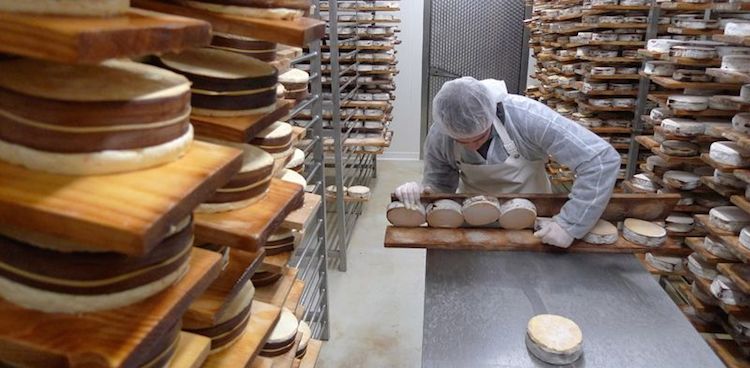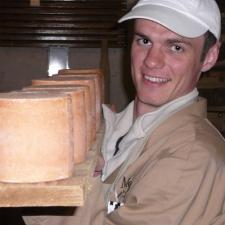
Vacherin is coming… Vacherin is coming…
For many years I have heralded the arrival of Vacherin Mont d’Or, and, I still find, each year, that this seasonal cheese is a delight to receive and enjoy for the first time of the year.
Vacherin Mont d’Or (also called Vacherin du Haut-Doubs in France) is a justifiably famous seasonal cheese only made in the autumn and winter. Encircled in spruce; rich, unctuous, and creamy; it is a delight – the perfect rich winter cheese! And in the worlds of Patrick Rance, Britain’s most-eminent cheesemonger, ‘Vacherin is the solace of the winter months’.
Most cheeses were originally only seasonally produced, but nowadays only a few remain as dairying and cheese production has become a year-round practice. Thankfully, production and consumption of Mont d’ Or has remained seasonal thanks to it’s AOP/AOC (Appellation d’Origine Contrôlée) by the French Government, which determines the regulations for producing this cheese: Officially this cheese cannot be made before August 15 each year. Once made, Vacherin Mont d’Or must then be matured for at least three weeks (and can therefore can be sold from September 10 onwards).
Vacherin Mont d’Or takes its name from the mountainous peak of Mont d’Or (1461 meters), which straddles the Swiss / French Border. But the origins of Mont d’Or cheese are hard to trace. As early as the 13th century there are records that cheeses encircled in wood were being made in the Haut-Doubs and Vaud regions. At this time Monks were still leading the cheesemaking crusade, and although there is no doubt that cheese was being made in The Alps before then – the monks were at the forefront of pioneering dairy farming and cheesemaking as we know it today. Clearing high pastures in the Alps, the monks created great swathes of land for high grazing in the summer to produce rich milk.

Cheesemaker strapping Vacherin Mont d’Or with Spruce bark to protect the rich cheese as it ages
With this rich Alpine milk the majority of cheeses were produced in spring and summer, as after the spring calving, kidding, and lambing, the animals go out on the most abundant and plush pasture and produce the best (and most milk): Hence, cheese was made as a way of preserving this milk for the leaner months.
But Mont d’Or isn’t even made in the summer, with it’s production being focused around autumn and winter.
This is because throughout the spring and summer, cheeses were being made in these high Alps in the Franche-Comte (the Doubs is a department in the Franche-Comte region). Using the fine pastures and the plentiful milk, small farmers decided to pool their milk and create local cooperatives or fruitières. Here, using the milk of many farms, they could make a large cheese that could then be aged to last them through the sinter: and so Gruyère and Comté were created.
But as summer ended the roads to the fruitière where the cheese was being made would often become inaccessible with snow. Couple this with colder weather (Gruyère and Comté are made from heating the curd up to a high temperature), and the fact the cows are reaching the end of their lactation and coming off the rich mountain pastures down into the valley. This would mean their milk becomes richer in fat and there is less of it to go around, this type of milk is better to make a smaller, softer cheese.*
Hence each farm would make a small cheese, in colder conditions that is quite rich and soft – perfect for their fatty milk. In fact, so rich and soft it would often have to be strapped up to stop it collapsing. They decided to do this with a product they could find locally all over the Alps – spruce bark, which imparts a resinous flavour to the cheese.
After being strapped in spruce bark the cheese is lightly-washed to encourage it to ripen (for 15 days). It helps that the Franche-Comte is also known for it’s salt mines, this salty washing solution helped create the dappled orange, and white fluffy rind (you can eat this rind – it’s edible!). After washing, Vacherin is squeezed into it’s characteristic spruce box, then aged – for a minimum of 21 days in total. Although I prefer them matured to 6-8 weeks to allow the unctuosity and rich, piney flavours to develop.

Because it has such a high percentage of milk fat, Vacherin Mont d’Or can be eaten with a spoon
Vacherin Mont d’Or is made this traditional way as it has been for many centuries (it was even recorded in letters to Parmentier in 1799). That is why it is nice that the seasonality remains, and as per the AOC is can only be made in the department of Doubs (in France) and the Vaud (in Switzerland) at altitudes of seven hundred plus meters.
The French version of Vacherin Mont d’Or is also still made using exclusively unpasteurised milk (Swiss is pasteurised) from traditional breeds of cows (Montbéliarde ou French Simmental). In 2009, eleven makers remained in France, of which Sancey Richard (Fromagerie du Mont d’Or) is perhaps the finest.
If you do get your hands on a Vacherin Mont d’Or this winter, be sure to savour it in all it’s glory, and, if you can – remember Britain’s eminent cheesemonger Patrick Rance’s advice on how to get the most out of eating your Vacherin: ‘If you are not in stuffy company: Lick the bark after each mouthful of cheese, and do not waste what is left; put it on the fire to die in a scent of glory’.
* For various technical reasons hard aged cheeses are better made from milk not too rich in fat as it holds too much moisture in the curd (Parmesan, Gruyère, and Comté are all made from partially skimmed milk, naturally skimming it by letting the cream settle to the top then taking it off).
Photo Credit: All images provided by Andy Swinscoe of The Courtyard Dairy




What is the composition of the cheese?
We received (and sold out) unpasteurized Swiss Vacherin Mont d’Or this year.
If only this glorious cheese would come my way!